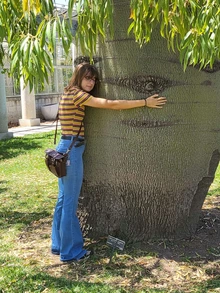meh·duh·tree·shn
Rooted in Connection: A mindfulness practice with trees.
This tour was designed to promote awareness and opportunities for connection. We will visit and get to know unique and inspiring trees and consider what they can teach us about ourselves and our relationships.
Begin this self-guided tour by locating the baobab tree on the southwest corner of the Administration Building. Locate the Administration Building using the Campus Map.
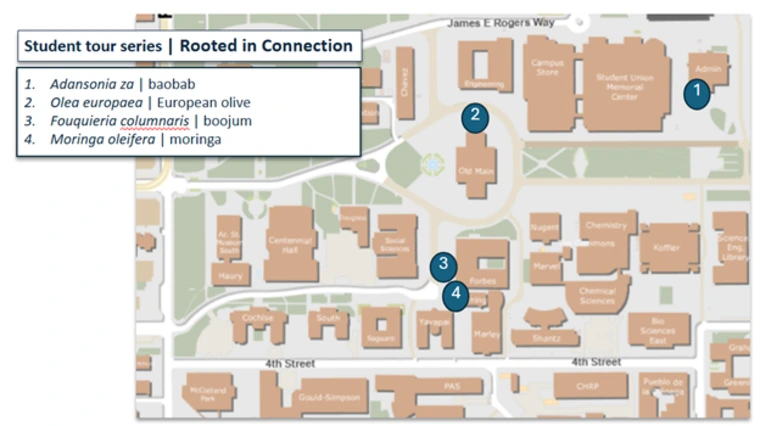
Introduction:
Thank you for joining us today for a meditative and informative tree tour! This tour was designed to promote awareness and opportunities for connection. In the human development and family sciences discipline, there is a concept known as “linked lives.” This concept suggests that we are not individuals living out individual lives in little bubbles, but rather that our experiences and lives cannot be separated out from our families, friends, and communities. Today, I want to extend that concept to include the plants linked to us within our communities as well. Plants are all around us, living their lives next to us–the plants surrounding us now are breathing in as we breathe out, and we are breathing in as they breathe out. I mean this in a very literal sense: plants breathe in carbon dioxide through pores on their leaves or bark and then breathe out oxygen. We do the very opposite, taking in oxygen to our lungs and breathing out carbon dioxide. The reality of our lives is that our breathing and the breathing of plants cannot be disentangled. That is about as linked as a life can get, no?
Today, then, I want to create a space for us to breathe together with four amazing trees who are living pillars of our community, our great friends and benefactors.
When we arrive at each tree, I will introduce you to them and tell you a little bit of their stories. Then, I’ll pose a question to you to ponder, and then we will take a few minutes to sit in silence with the tree. You can close your eyes or keep them open, journal, stretch, whatever you like. During our quiet time, I encourage you to return again and again to the notion of breathing with the tree. Ponder the question for as long as is helpful, but if your mind begins to tell you about all the worries and fears of the day, simply return your attention back on the tree in front of you, and begin breathing with it again, knowing that as you breathe in, the tree breathes out. As you breathe out, the tree breathes in.
Before we begin exploring the different trees of this tour, I’d like to take a moment to check in. My hope is that this tour can be a place to find some peace and learn about a few wonderful plants here on campus, but I realize that it can be difficult to feel comfortable sitting in silence with strangers, and in public spaces where other people are walking by. So, to help us get to know each other and ease us into the space, I’d like to ask everyone to share their name, and maybe one thing they are feeling or thinking about right now. If you don’t want to respond, feel free to just say, “pass.” I’ll start, my name is __, and I’m feeling __.
Thank you everyone for sharing. Now that we know a little bit about each other, let’s turn and get to know our first tree friend.
Species name: Adansonia za
Common name: baobab
Location: southwest corner of Administration building
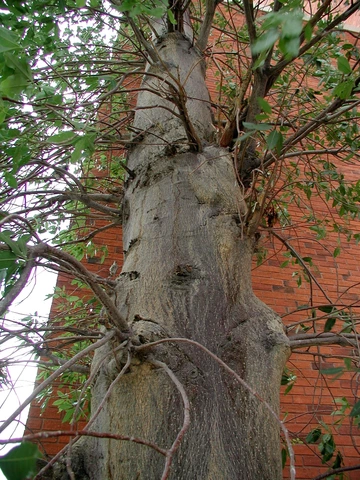
Adansonia za at the administration building on campus
The baobab are a famous group of trees from Madagascar, Africa, and Australia. This one is from Madagascar, where it is a beloved part of people’s communities. It is a useful plant, and every part of it is edible and medicinal. These trees also can hold thousands of gallons of water in their trunks, which they store for times of drought (pass around picture). Elephants often eat the bark of this tree when they can’t find water anywhere else—they rely on baobabs! My favorite fact about this tree is that it is believed in Northern Madagascar to house ancestral spirits, and it’s a practice to embrace the tree as a respectful greeting. Who doesn’t want to hug a big, smooth tree? I certainly want to.
This tree is a centerpiece of African communities, and it is also a cherished member of ours. This particular baobab was planted in honor of Libby Davison, the founding director of the Campus Arboretum. She was a centerpiece of the Tucson community through her work to nurture all the beautiful plants here on campus, and it is a fitting tribute to have a baobab growing in her honor.
Additionally, this tree was recognized in 2024 by the Arizona Department of Forestry, Urban and Community Forestry Division as a State Champion and Magnificent Tree! This award recognizes species that are unusually large, rare, or historic. People from across the state collect information and nominate their favorite trees by submitting an application to this program. After evaluating the application, the State Forester’s office determines whether they earn a title. Thanks to them, this baobab is now part of all of Arizona’s community!
This tree, then, is a centerpiece of any community it is a part of. It gives food to people, and they in return give it respect and hugs, and plant it in dedication to cherished people. It gives water to elephants, because it has enough to go around.
So as we sit here for the next few minutes, I’d like to ask you to think about the centerpieces of your community:
Who are the people you cherish?
Who can you turn to in times of drought?
Species name: Olea europaea
Common name: European olive
Location: north side of Old Main
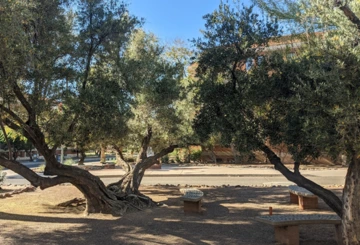
Olive tree at Old Main
These European olives are some of the most famous trees on campus. They were originally planted as agricultural experiments but have since become icons in modern campus life. This particular type of olive tree can live up to 600 years, and ours were planted about 100 years ago. They still have a long way to go! These trees can thrive and yield fruit in poor soil without added nutrition. Because of their ease in growing and adaptability, they have given food to people for thousands of years.
Our question, then, is about time. These dear trees cannot get up and walk away when the going gets tough. They must be adaptable and ready within their own bodies to withstand whatever may come, for 600 years! So, as we sit here for the next few minutes:
What would change for you if you had to sit here for the next 500 years, or maybe just the next hour?
What inner resources could you call upon?
Species Name: Moringa oleifera
Common name: moringa
Location: between Forbes building and Herring Hall
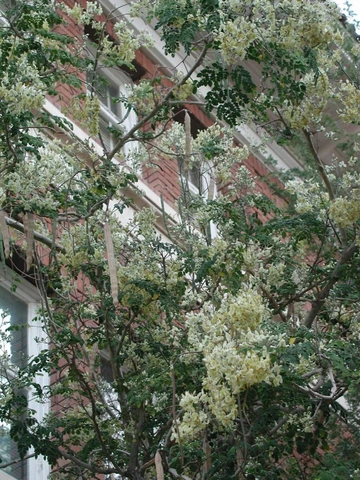
This tree is called the moringa tree, but another apt name for it could be The Giving Tree! Every part of it is edible and HIGHLY nutritious. It was introduced here from India, originally to restore disturbed areas thanks to its quick growth and adaptability to a variety of environments. In India, every part of this tree is eaten or used medicinally. Even waste-oil extracted from the seeds acts as a powerful coagulant that can be used to clean water. This tree has something to give in every cell of its body, and its quick growth means that it can give and then bounce back easily.
My question to you, conversely, is about receiving. This member of our community gives openly, almost joyfully. I wonder what happens within us when someone turns to us and offers us help so openly and generously. When we sit in front of this beautiful giving tree, I wonder how we feel. So, as we sit here for the next few minutes, I ask you:
How do you receive? Do you allow yourself to receive kindness? Remember, you can always come back to breathing with the tree.
Species name: Fouquieria columnaris
Common name: boojum
Location: southwest corner of Forbes building
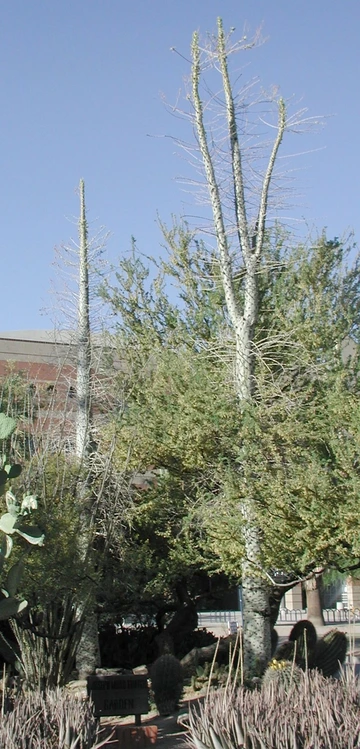
These are some of the weirdest and wildest trees you can find! Ours is just a baby boojum, but at maturity this plant can reach 80 feet! Imagine this weird pokey friend towering over your head, looking almost exactly like it does right now. This friend was named after a tree in one of Lewis Carroll’s fantastical poems, The Hunting of the Snark. They grow exclusively in Baja California, and are known for their writhing, wiggly shapes. In Baja, they grow straight up and down when they are inland, like our friend here, but the closer to the coast they are, the wigglier they become! (Pass around picture!) Can you imagine walking along the beach, and coming upon a hillside full of these trees?
For many, these plants help them see the magic in life. On days when life feels routine and magicless, the Boojum is a reminder that life is jam-packed with unexpected whimsy, if you know where to look!
Our question, then, is about embracing ourselves for the very ones that we are. If we can embrace the boojum and celebrate its whimsy, could we also do that for ourselves? As we sit here for the next few minutes, I wonder:
What whimsy inside of you is longing for your recognition, your acceptance, and your celebration?


